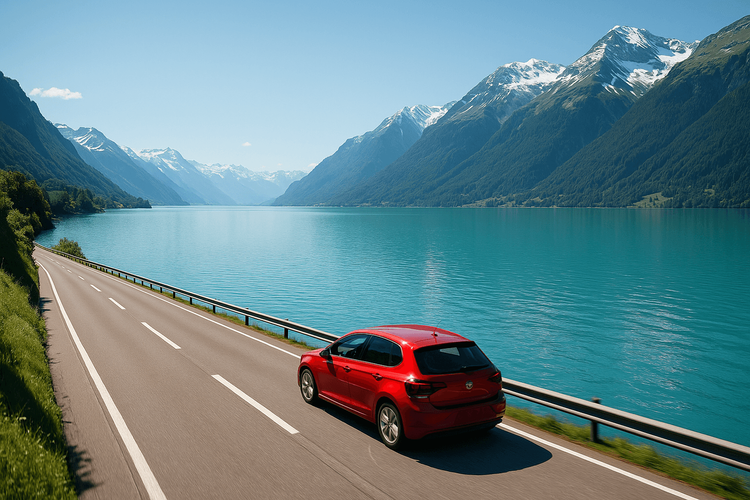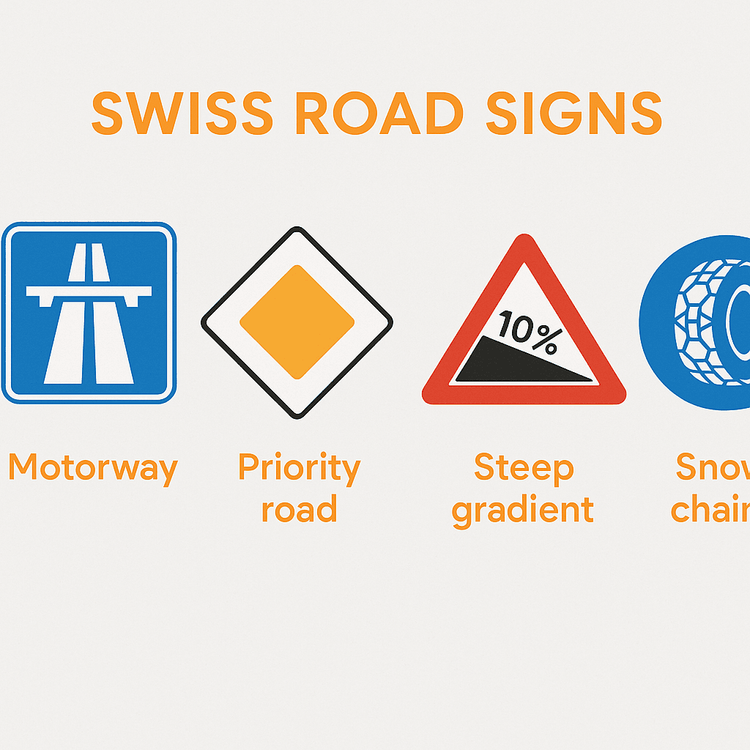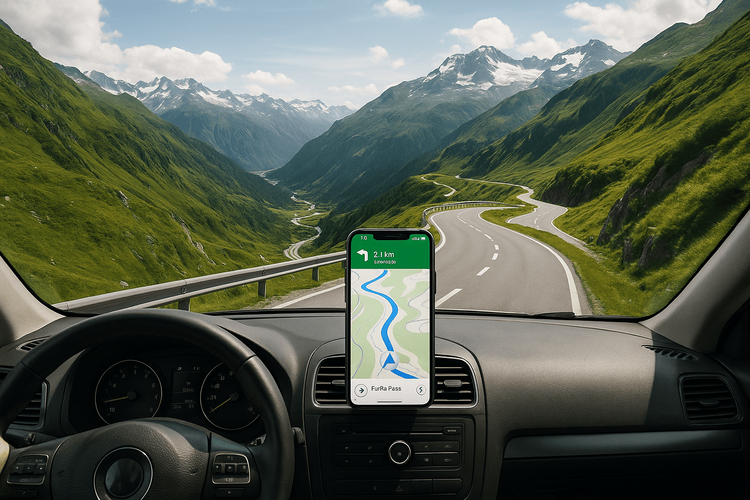There’s no better way to experience the dramatic landscapes of Switzerland—from its shimmering lakes to its jaw-dropping Alpine passes—than from behind the wheel. A Switzerland road trip offers unparalleled freedom to explore at your own pace. But before you hit the road, it’s crucial to understand the local driving essentials: the motorway toll (vignette), unique traffic rules, and how to stay connected for a smooth journey.
Before you even start the engine, ensure you’re connected. With a Yoho Mobile eSIM, you can have high-speed data access the second you arrive, making everything from navigation to checking into your hotel a breeze. Explore our Switzerland eSIM plans today!

The Swiss Vignette: Your Ticket to the Motorways
First things first: to drive on Switzerland’s motorways (autobahnen), you must have a vignette. This is essentially a prepaid motorway tax sticker that is mandatory for all cars, motorcycles, and vehicles up to 3.5 tonnes.
How to Get and Use the Vignette
- Types: You can get a traditional sticker vignette or a digital e-vignette linked to your license plate.
- Where to Buy: You can purchase the sticker vignette at border crossings, post offices, and gas stations throughout Switzerland. For convenience, the e-vignette can be purchased online from the official Swiss government portal before your trip.
- Cost and Validity: The vignette costs CHF 40 and is valid for the entire calendar year (from December 1st of the previous year to January 31st of the next).
- Placement: The sticker must be affixed directly to the inside of your windshield, either behind the rearview mirror or on the driver’s side. Do not just tape it on; it must be properly stuck to be valid.
A quick tip on rental cars: If you rent a car within Switzerland, it will almost certainly come with a valid vignette. However, if you’re driving a rental car from a neighboring country like Germany or France, you will need to purchase a vignette yourself before entering any Swiss motorways.
Key Swiss Driving Rules for Tourists
Driving in Switzerland is generally a pleasant experience, thanks to well-maintained roads and courteous drivers. However, there are some specific rules you must follow to ensure a safe and fine-free trip.

Essential Regulations to Remember:
- Drive on the Right: Traffic flows on the right-hand side of the road.
- Headlights On: Dipped headlights are mandatory 24/7 for all vehicles, even on bright, sunny days.
- Speed Limits: Unless otherwise posted, the national speed limits are:
- Motorways: 120 km/h (75 mph)
- Expressways: 100 km/h (62 mph)
- Outside built-up areas: 80 km/h (50 mph)
- Inside built-up areas (towns/villages): 50 km/h (31 mph)
- Mountain Roads: On narrow mountain passes, uphill traffic generally has the right of way. Postal buses (the yellow buses) always have priority and will signal with a distinctive three-tone horn.
- Trams: In cities like Zurich and Geneva, trams always have priority.
- Documents: Always carry your valid driver’s license, vehicle registration, and proof of insurance. For many non-European license holders, an International Driving Permit (IDP) is also required. You can check the requirements with your local automobile association.
Staying Connected for a Seamless Switzerland Road Trip
For a modern road trip, a reliable internet connection is as essential as a full tank of gas. You’ll need it for navigation, looking up restaurants, checking opening times, and most importantly, getting real-time traffic updates. Relying on expensive international roaming or hunting for a local SIM card at the airport can be a hassle.
This is where an eSIM from Yoho Mobile transforms your travel experience. You can purchase and install your data plan before you even leave home. For iOS users, the process is incredibly simple: after purchase, just tap ‘Install’ to begin the setup, with no QR codes to scan. It’s the best way to stay connected while driving in Switzerland.
Don’t let spotty connections ruin your scenic drive. With Yoho Mobile’s flexible eSIM plans, you can customize your data for your exact travel dates. Build your perfect Switzerland plan now!
Real-Time Traffic Alerts and Navigation
Switzerland’s geography means that road conditions can change quickly, especially in the Alps. Mountain passes can close due to snow (even in early summer), and traffic can build up around major cities. Using a navigation app with live traffic data is non-negotiable.

Apps like Google Maps or Waze are excellent for getting real-time traffic updates for the Swiss Alps, rerouting you around accidents, and warning you of congestion. This requires a stable data connection.
Imagine you’re navigating a tricky mountain pass and your data plan unexpectedly runs out. It’s a stressful thought that could leave you stranded. That’s why Yoho Care is a game-changer for road trippers. Even if your main data package is depleted, Yoho Care provides a backup connection to ensure you’re never truly offline or lost, giving you invaluable peace of mind. Learn more about the security of Yoho Care.
Also, ensure your phone is compatible with eSIM technology before your trip. You can easily check on our eSIM compatible devices list.
Frequently Asked Questions (FAQ)
Do I need an International Driving Permit for driving in Switzerland?
It depends on the country that issued your license. While licenses from EU/EFTA countries are generally accepted, those from many other countries (including licenses not in English, German, French, or Italian) require you to carry an International Driving Permit (IDP) alongside your original license.
What is the best way to stay connected while driving in Switzerland?
An eSIM is the most convenient and cost-effective option. You can set it up before your trip, avoiding expensive roaming charges and the search for a physical SIM card upon arrival. A provider like Yoho Mobile offers flexible plans tailored to your trip’s length and data needs.
Is it difficult to drive in the Swiss Alps?
While the roads are well-engineered, driving on mountain passes requires caution. Be prepared for sharp turns, steep gradients, and narrow sections. Drive slowly, use a lower gear to control your speed on descents, and be aware of changing weather conditions. Always check if passes are open before you start your journey.
Can I use my phone as a GPS without using a lot of data?
Yes. Navigation apps like Google Maps use a relatively small amount of data for routing. To save even more, you can download offline maps for Switzerland before you leave home or while on Wi-Fi. However, you will still need a data connection for live traffic updates, which is highly recommended.
Conclusion
A road trip through Switzerland is an experience of a lifetime, filled with breathtaking views at every turn. By preparing in advance—securing your Swiss vignette, understanding the key traffic rules, and ensuring you have reliable connectivity—you can make your journey smooth, safe, and entirely stress-free.
Ready for the drive of a lifetime? Start by getting your connectivity sorted. Try Yoho Mobile with a risk-free trial and experience seamless internet from the moment you land. Get your free trial eSIM now!
